Services on Demand
Journal
Article
Indicators
-
 Cited by SciELO
Cited by SciELO -
 Access statistics
Access statistics
Related links
-
 Cited by Google
Cited by Google -
 Similars in
SciELO
Similars in
SciELO -
 Similars in Google
Similars in Google
Share
Ciencia y Tecnología Agropecuaria
Print version ISSN 0122-8706On-line version ISSN 2500-5308
Cienc. Tecnol. Agropecuaria vol.21 no.1 Mosquera Jan./Apr. 2020 Epub Dec 30, 2019
https://doi.org/10.21930/rcta.vol21_num1_art:1372
Fisiología animal
Reproductive indicators in bovine cohorts that drink treated water that comes from oil production as the only source in different dilutions with deep-well water
1Investigador PhD, Corporación Colombiana de Investigación Agropecuaria (AGROSAVIA), CI La Libertad. Villavicencio, Colombia.
2Investigador-docente, Universidad de Los Llanos, Facultad de Ciencias Agropecuarias y Recursos Naturales. Villavicencio, Colombia.
3Investigador MSc, Corporación Colombiana de Investigación Agropecuaria (AGROSAVIA), CI La Libertad. Villavicencio, Colombia.
4Profesional de Apoyo a la Investigación, Corporación Colombiana de Investigación Agropecuaria (AGROSAVIA), CI La Libertad. Villavicencio, Colombia.
5Investigador Docente, Universidad Cooperativa de Colombia. Facultad de Medicina Veterinaria y Zootecnia. Villavicencio, Colombia.
6Profesional de Apoyo a la Investigación. Corporación Colombiana de Investigación Agropecuaria (AGROSAVIA), CI La Libertad. Villavicencio, Colombia.
7Profesional de Apoyo a la Investigación. Corporación Colombiana de Investigación Agropecuaria (AGROSAVIA), CI La Libertad. Villavicencio, Colombia.
The effect of consuming treated water from oil production on the reproductive indicators of dualpurpose bovine females was assessed. The study was carried out at the municipality of Villavicencio, department of Meta, Colombia. Twenty-four F1 Cebu x Holstein Friesian cows were selected and randomly distributed in four treatments, each treatment with the permanent disposition of a previously tested reproductive bull. The selected groups consumed water at will of treated production under grazing conditions, as follows: 1. 100 % treated production water, 2. mixture of 50 % of treated production water and 50 % of deep-well water (DWW), 3. mixture of 25 % of treated production water and 75 % of DWW, and 4. 100 % of DWW (Control). The variables evaluated in each animal were: age at first birth (AFB), age at first conception (AFC), interval between births (IBB), birthconception interval (BCI), and the number of calves/cow per year or birth rate. The statistical analysis included Shapiro-Wilk and normality tests, one-way analysis of variance, and the Kruskal-Wallis test, employing the SPSS-22 software to carry out the analyses. The results found indicated for AFB and AFC between treatments, means that ranged from 20.8 and 25.1 months and 30.2 to 34.5 months, respectively, without significant differences (p > 0.05). The variables IBB, BCI, and birth rates showed means between 339 to 466 days, 57 to 184 days, and 0.78 to 1.08, respectively. No significant differences were found between the animals that consumed and did not consume treated production water.
Keywords age at first birth; cattle; dual purpose; interval between births; reproductive behavior
En el presente artículo se estudió el efecto del consumo de agua tratada proveniente de la producción del petróleo sobre indicadores reproductivos de la hembra bovina de doble propósito. Este se desarrolló en el municipio de Villavicencio, departamento del Meta, Colombia. Los animales seleccionados fueron 24 vacas F1, Cebú × Holstein Friesian, distribuidos al azar en cuatro tratamientos, cada uno con disposición permanente de toro reproductor previamente probado y que consumieron agua a voluntad de producción tratada utilizada bajo condiciones de pastoreo, así: 1) 100 % de agua de producción tratada, 2) mezcla de 50 % de agua de producción tratada y 50 % de agua de pozo profundo (PP), 3) mezcla de 25 % de agua de producción tratada y 75 % de agua PP, y 4) 100 % de agua PP (control). Las variables evaluadas en cada animal fueron las siguientes: la edad al primer parto (EPP), la edad a la primera concepción (EPC), el intervalo entre parto (IEP), el intervalo parto concepción (IPC), número de terneros/vaca año o tasa de natalidad. El análisis estadístico comprendió prueba de normalidad, Shapiro-Wilk, análisis de varianza de una vía y prueba de Kruskall-Wallis; además, se empleó el software SPSS-22. Los resultados encontrados indicaron para EPC y EPP entre tratamientos medias que oscilaron 20,8 y 25,1 meses y 30,2 a 34,5 meses, respectivamente, sin diferencias significativas (p > 0,05). Las variables IEP, IPC y tasas de natalidad estuvieron entre 339 a 466 días, 57 a 184 días, y 0,78 a 1,08, respectivamente. No se encontraron diferencias entre los animales que consumieron y no consumieron agua de producción tratada.
Palabras clave comportamiento reproductivo; doble propósito; edad al primer parto; ganado bovino; intervalo entre parto
Introduction
The oil in Colombia, when extracted, is mixed with water known as “production water” and is part of the natural fluids of the deposits. In the country, 13 barrels of water are produced for every barrel of oil extracted. Production waters can be treated and reinjected in the same geologic formation to maintain reservoir pressure and increase the “recovery factor;” these can also be treated and discharged to surface water bodies or to the ground, or re-injected into reservoirs as an alternative final disposition (Almansa, Velásquez, & Izquierdo, 2018).
When production waters are not treated properly, they can generate impacts on the environment, contaminating surface and deep waters (Al Hashemi, Maraqa, Rao, & Hossain, 2014). The composition and chemical characteristics of associated hydrocarbon production waters are related to the geological conditions of each reservoir. This composition is complex and can comprise several thousand compounds that vary in concentration between the deposits (Bakke, Klungsøyr, & Sanni, 2013). The health effects of untreated production waters in cattle range from neurological, reproductive, gastrointestinal, and liver problems (American Petroleum Institute, 2004).
Studies in cattle of dual-purpose systems (DP) on consumption of treated production water and from the extraction of oil in their production and health were carried out by Almansa et al. (2018); this work did not report changes that show alterations in productive indicators and macro and microscopic evaluations of the organs and tissues of the experimental animals. Dual-purpose cattle production systems in Colombia are found in all thermal levels (i.e., at different elevations), and to a greater extent, on the slopes of the mountain ranges and valleys of the Andean, Atlantic Coast and the Orinoquia regions, between 0 and 1,500 m a.s.l., with a predominance of cattle crossings between Bos indicus and Bos taurus species (Departamento Administrativo Nacional de Estadística [DANE], 2015). The inventory of the DP herd is estimated at 8,216,258 heads, i.e., 35 % of the national herd (Federación Colombiana de Ganaderos [Fedegán], 2016) included in the national bovine population that comprises 23,475,022 heads (Instituto Colombiano Agropecuario [ICA], 2017).
The DP system usually has low productive and reproductive efficiency (Vergara, Botero, & Martínez, 2009), and the most critical indicator is the birthconception interval (Salgado et al., 2003). The increase in milk production and the maintenance of lactation are associated with a decrease in reproductive efficiency (Niozas et al., 2018; Rodríguez, & Martínez, 2010). An association between increased milk production and the increased incidence of abnormal ovarian cycles with prolonged luteal phases has also been demonstrated (Kafi et al., 2012, cited by Remnant, Green, Huxley, & Hudson, 2015). In the DP system, the calf remains with the cow between 5 and 8 hours after milking, as indicated by Pérez et al. (2001), based on the study by Escobar et al. (1984, cited by Pérez et al., 2001), which in some cases may cause temporary postpartum anestrus and increase in open days.
Age at first birth (AFB) in herds of the dual-purpose system has been reported between 38 and 41 months (Arellano et al., 2006; Cipagauta, Ossa, & Hernández, 2001; Navarrete et al., 1995; Vergara et al., 2009), and depends on the management and nutrition offered during the growth period (Granja, Cerquera, & Fernández, 2012). Its early expression is associated with a higher number of calves and milk quantity during its productive life (Vergara et al., 2009). The interval between births (IBB) found by some authors is reached at 16.9 months (López, Arellano, Briones, & Velasco, 2015), 15.6 months (Vergara et al., 2009), 15.8 months (Arellano et al., 2006) and 15.4 months (Cipagauta et al., 2001). Accordingly, the aim of this study was to evaluate the effect of treated production water consumption from hydrocarbon extraction, on the reproduction of bovine females of the dual-purpose system.
Materials and methods
The study was conducted in the Research Center CI La Libertad of Corporación Colombiana deInvestigación Agropecuaria (AGROSAVIA), located in the foothills of the Llanos Orientales subregion of Colombia, at an altitude of 336 m a.s.l., with an average temperature of 26 °C, an annual average rainfall of 2,950 mm3, 75-78 % of relative humidity, and 4-7 hours of solar brightness. The treated production water was obtained from the Apiay oil field of Ecopetrol. Four treatments were prepared with treated oil extraction water authorized for discharge by the Ministry of Environment, under the regulatory use framework of Decree 1594 of 1984, called production water, as well as a control as the only source of water for experimental animals, as follows: production water from the Apiay oil field before being poured into natural water streams and two mixtures of this water in a proportion of 50 % and 25 %, which were adjusted with deep-well water from the control treatment and used for animal consumption. These treatments were supplied daily with treated production water of the Apiay oil field.
Twenty-four pregnant cows with an age of 4 to 5 years from Cebu × Holstein Friesian crosses of the DP system were selected and randomly distributed in four treatments. A reproductive bull was assigned to each treatment after satisfactory spermogram evaluation, being changed every three years in an area of 7 ha, with Brachiaria decumbens Stapf (Poaceae) pastures and with access to the treatment water at will. These spaces were equally enlarged without changing their conditions according to the growth of the groups.
The design corresponded to a completely randomized longitudinal prospective study. The cows that initiated the cohorts (four in total) entered the experiment on May 16, 2007, with an average age of 4 years, and remained until June 30, 2015. The observation period was comprised of 2,967 days. From the animals that were born up to weaning, the males were extracted from the weaning cohort, vand the females continued and were incorporated into the maternal cohort. During the lactation period, the day before milking, the calves were separated from their mothers to independent pastures, with water availability.
The reproductive indicators calculated were the following: age at first birth (AFB) in months, which corresponded to females born within the cohorts of each treatment, and the interval between births (IBB) in days, for cows introduced at the beginning of the treatments and those born within each cohort.
Age at first birth (AFB) in months = (date of first birth - date of birth) / 30
Interval between births (IBB) = Day elapsed between two consecutive births.
Age at first conception (AFC) in months = (AFB in days - 282 days of gestation) / 30
Birth rate: (1 / IBB) * 365 = calves / cow per year
Birth-conception interval (BCI) = IBB - 282 days of gestation
The statistical analysis included normality and Shapiro-Wilk tests for AFB and IBB; if a normal distribution was found, a one-way analysis of variance was run; on the contrary, when no normality was obtained, the Kruskal-Wallis test was used. All tests were performed with the SPSS-22 software.
Results and discussion
The results indicate that the age at first birth did not show significant differences between the treatments (p> 0.05) (table 1), a response that follows the same behavior for the derived variable age at first conception.
The general mean for age at first conception and first birth was 22.2 and 31.6 months, respectively, and between treatments, these indicate maximum values for the two variables (25.1 and 34.5 months), respectively. In the 25 % production water consumption treatment, and in the minimum average values (20.8 and 30.2 months) found in the treatment of 100 % production water consumption (table 2), periods of less than 27 months for average age at first mate (Fedegán, 2012) and for AFB (Arellano et al., 2006; Cipagauta et al., 2001; Navarrete et al., 1995; Vergara et al., 2009) were reported. If the age for the first conception is assumed through calculation from the review performed, the result obtained in this study for this variable would be lower than the one referenced.
Table 1. Analysis of variance for age at first birth by the percentage of treated production water from the Apiay oil field, Agrosavia, ci La Libertad
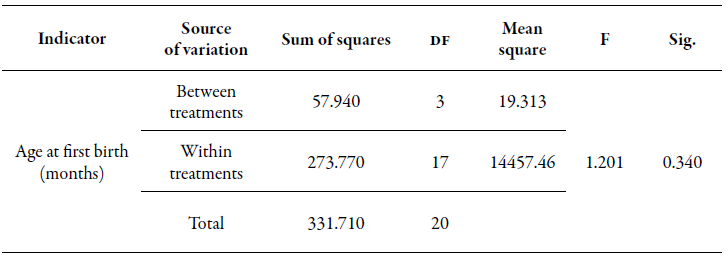
DF: Degrees of freedom; Sig.: Significance.
Elaborated by the authors
Table 2. Average values for age at first conception and first birth in cows born in cohorts per treatment
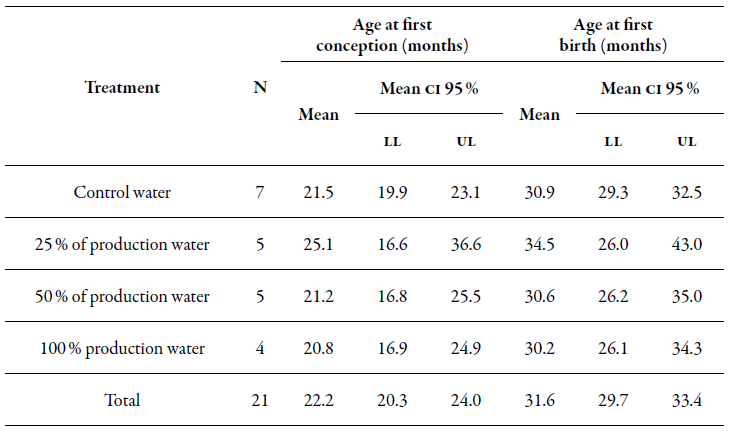
LL: Lower limit; UL: Upper Limit.
Elaborated by the authors
Table 3. Kruskal-Wallis test for the interval between births by treatments, cows introduced and born in the experiment, and birth number
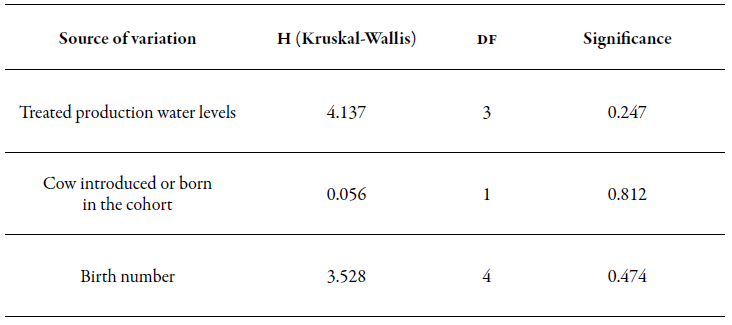
DF: Degrees of freedom.
Elaborated by the authors
The interval between births did not show significant differences between treatments (p > 0.05), nor between cows born or introduced in cohorts or by birth number (table 3).
The birth rate or calves/cow/year and the BCI, as they are variables derived from the IBB, are enough to infer that there were also no significant differences (p > 0.05).
The general medians of the IBB, BCI, and number of calves/cow per year were 422 days (14.07 months), 140 days (4.67 months), and 0.87 calves (87 % birth rate), respectively. The response obtained between treatments did not show significant differences (p> 0.05). Further, the treatment with the lowest median value for IBB (339 days) was 25 % of production water, a response that would be among the optimal values expected in a DP bovine production system; the other results were the control, and 50 % and 100 % of production water treatments with 414, 399 and 466 days, respectively. These responses are below 16 months and are comparable with those described by Cipagauta et al. (2001) and lower than those reported by Arellano et al. (2006), López et al. (2015), and Vergara et al. (2009). The IBB indicates changes between treatments that vary between 57 and 184 days whose behavior, being derived from the IBB, is similar (p > 0.05). For the control, and 25 % and 50 % of production water treatments, responses are also observed with median values below 120 open days and, for the treatment with 100 % production water, the response was 184 days, similar to the calculated averages of the intervals between births reported by Cipagauta et al. (2001), and lower than those reported by Arellano et al. (2006), López et al. (2015) and Vergara et al. (2009). The variable calves/cow per year or birth rate indicates median values between treatments of 0.78 to 1.08, results higher than 0.53 reported by Fedegán (2011) (table 4).
When the analysis is performed considering the origin of the cows, born or introduced, no significant changes are observed, and their responses are very similar with 426 and 418 days for IBB, 144 and 136 days for BCI, and 0.86 and 0.87 for birth rate.
Table 4. Median values for the interval between births (IBB), birth-conception interval (BCI) and birth rate by treated production water levels, and cows born or introduced in cohorts
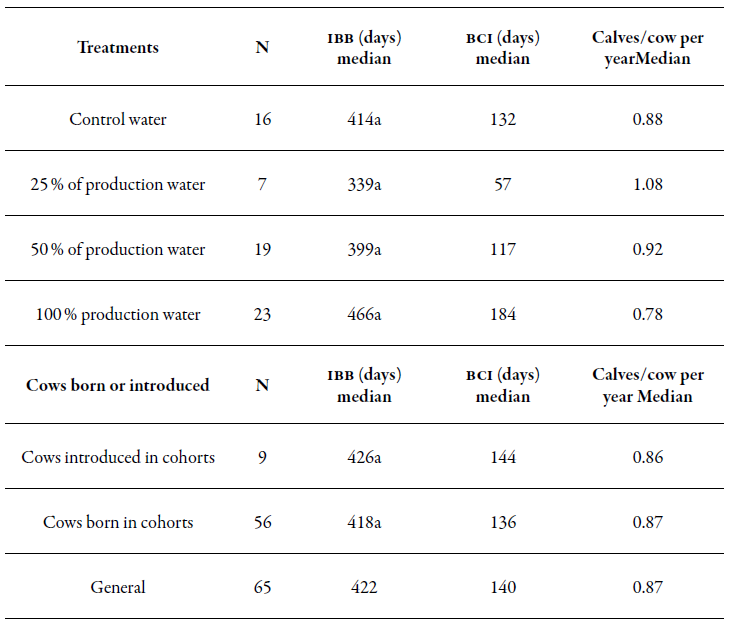
IBB: Interval between births; BCI: Birth-conception interval.
Elaborated by the authors
The behavior for the IBB and its derivatives BCI and birth rate in the successive birth sequences (1-2, 2-3, 3-4, 4-5, 5-6) analyzed by the Kruskal-Wallis test run for independent samples for each production water treatment, did not show changes that allow defining significant differences (p > 0.05) for percentages of production water by birth number, by rows and columns (table 5). The behavior of the IBB medians is irregularly shown between the birth sequences, a response that is possibly given by the fractionation of (n) by the birth sequence, contrary to the results of Arellano et al. (2006), which show a downward behavior over time. However, the control and 100 % production water treatments show the contiguous responses for most of the series evaluated (1-2 [415-499 days], 3-4 [369-427 days], 4-5 [463-457 days] and 5-6 [445-479 days]), and at a general level (414-422 days), answers that could be explaining the nonassociation of the behavior of this variable with the consumption of treated production water.
Table 5. Median intervals between births, birth-conception interval and birth rate by treatment and birth number for cohorts that consumed different mixtures of treated production water in Agrosavia, CI La Libertad
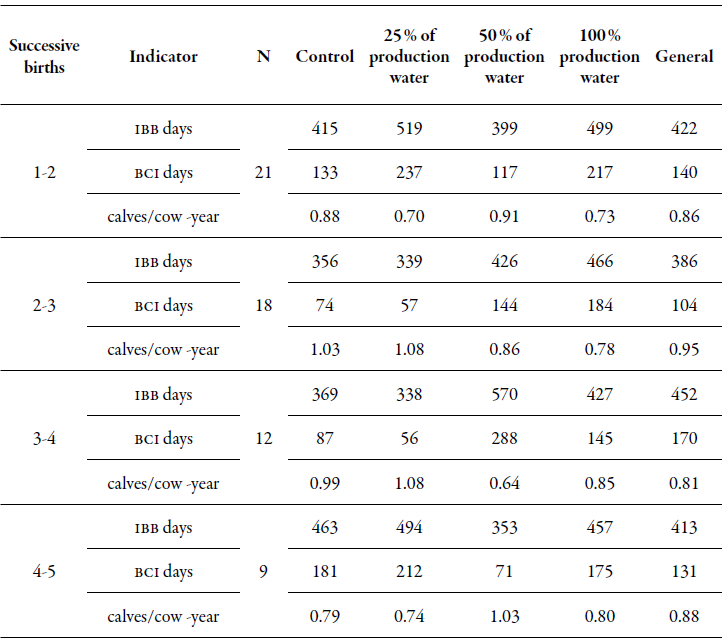
IBB: Interval between births; BCI: Birth-conception interval; Calves/cow per year = Birth rate.
Elaborated by the authors
Table 5 Median intervals between births, birth-conception interval and birth rate by treatment and birth number for cohorts that consumed different mixtures of treated production water in Agrosavia, CI La Libertad
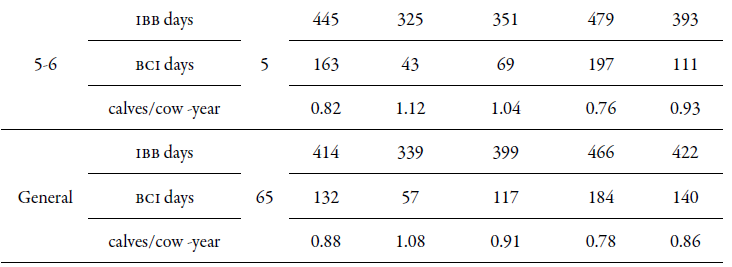
IBB: Interval between births; BCI: Birth-conception interval; Calves/cow per year = Birth rate.
Elaborated by the authors
Conclusions
Under the scenario in which this research was carried out, we conclude that the reproductive indicators evaluated, i.e., age at first birth, age at first conception, interval between births, birth-conception interval and birth rate, were not affected by consumption of treated production water associated with oil extraction from the Apiay oil field in the foothills of the department of Meta. The values obtained are comparable to those reported in the literature under normal conditions.
Acknowledgments
The authors wish to thank Corporación Colombiana de Investigación Agropecuaria (AGROSAVIA) and Ecopetrol for financing the development of this research under the Agrosavia-Ecopetrol agreement number 5211320.
REFERENCES
American Petroleum Institute. (2004). Risk-based screening levels for the protection of livestock exposed to petroleum hydrocarbons. Recuperado de https://www.api.org/environment-healthandsafety/environmentalperformance/~/~/media/files/ehs/environmental_performance/final_as_published_4733.ashx. [ Links ]
Al Hashemi, W., Maraqa, M. A., Rao, M. V., & Hossain, M. (2014). Characterization and Removal of Phenolic Compounds from Condensate-Oil Refinery Wastewater. Desalination and Water Treatment, 54(3), 660-671. doi:10.1080/19443994.2014.884472. [ Links ]
Almansa, E., Velásquez, J. G., & Yzquierdo, G. A. (2018). Efecto del uso de aguas provenientes de la producción petrolera en actividades agrícolas y pecuarias. Corpoica Ciencia y Tecnología Agropecuaria, 19(2), 403-420. doi:10.21930/rcta.vol19_num2_art:1016. [ Links ]
Arellano, S., Martínez, J., Romero, E., Briones, F., Domínguez, M., & De la Garza, F. (2006). Factores genético-ambientales que afectan el intervalo entre partos y días a primer parto en ganado de doble propósito en el norte de Veracruz. Revista Avances en Investigación Agropecuaria, 10(1), 43-53. [ Links ]
Bakke, T., Klungsøyr, J., & Sanni, S. (2013). Environmental Impacts of Produced Water and Drilling Waste Discharges from the Norwegian Offshore Petroleum Industry. Marine Environmental Research, 92, 154-169. doi:10.1016/j.marenvres.2013.09.012. [ Links ]
Cipagauta, M., Ossa, G., & Hernández, C. (2001). Comportamiento productivo de cruces Bos taurus x Bos indicus en un proceso de mejoramiento genéticos con bovinos doble propósito del piedemonte Caqueteño. Boletín Técnico. Florencia, Colombia: Corporación Colombiana de Investigación Agropecuaria (Corpoica). [ Links ]
Departamento Administrativo Nacional de Estadística (DANE). (2015). Insumos y factores asociados a la producción Agropecuaria. Boletín mensual. Recuperado de https://www.dane.gov.co/files/investigaciones/agropecuario/sipsa/Bol_Insumos31_abr_2015.pdf, [ Links ]
Federación Colombiana de Ganaderos (Fedegán). (2012). Foro de empresarización y competitividad ganadera: Costos y los indicadores de productividad en la ganadería colombiana. Recuperado de https://www.fedegan.org.co. [ Links ]
Federación Colombiana de Ganaderos (Fedegán). (2016). Cifras referenciales del sector ganadero colombiano. Recuperado de https://estadisticas.fedegan.org.co. [ Links ]
Federación Colombiana de Ganaderos (Fedegán). (2011). Oficina de Investigaciones Económicas Consensos ganaderos. Recuperado de http://www.fabegan.org/upload/publicaciones/Proyecciones%20de%20la%20ganadería%20Colombiana.pdf. [ Links ]
Granja, Y. T., Cerquera, J., & Fernández, O. (2012). Factores nutricionales que interfieren en el desempeño reproductivo de la hembra bovina. Revista Colombiana de Ciencia Animal, 4(2), 458-472. doi:10.24188/recia.v4.n2.2012.227. [ Links ]
Instituto Colombiana Agropecuario (ICA). (2017). Censo Pecuario Nacional. Recuperado de https://www.ica.gov.co/Areas/Pecuaria/Servicios/Epidemiologia-Veterinaria/Censos-2016/Censo-2017.aspx. [ Links ]
López, C. B. I., Arellano, S., Briones, F., & Velasco, R. (2015). Intervalo entre parto en ganado suizo por cebú en el norte de Veracruz. J. M. Gochicoa Matienzo (Presidente), Memorias Congreso Mundial de Ganadería Tropical. Recuperado de https://www.engormix.com/ganaderia-carne/articulos/intervalo-entre-partos-ganado-t32003.htm. [ Links ]
Navarrete, M., Abuabara, Y., Mendoza, G., Martínez, G., Corredor, G., Serrano, G., & Dueñas, G. (1995). Evaluación de la reproducción en ganaderías de doble propósito en Córdoba. Boletín Avances en Monitoreo Ganadero, 2(1995). [ Links ]
Niozas, G., Tsousis, G., Steinhofel, I., Brozos, C., Romer, A., Wiedemann, S., & Kashe, M. (2018). Extended Lactation in High-Yielding Dairy Cows. Effects on Reproductive Measurements. American Dairy Science Association, 102(1), 1-12. [ Links ]
Pérez. H. P., Becerril, C. M., Lamothe, C., Torres, G., López, S., & Gallegos, S. (2001). Efecto del amamantamiento retrasado en la actividad postparto de las vacas y en los becerros de doble propósito. Interciencia, 31(10), 748-752. [ Links ]
Remnant, J. G., Green, M. J., Huxley, J. N., & Hudson, C. D. (2015). Variation in the Interservice Intervals of Dairy Cows in the United Kingdom. American Dairy Science Association, 98(2), 889-897. doi:10.3168/jds.2014-8366. [ Links ]
Rodríguez, Y., & Martínez, G. (2010). Efecto de la edad al primer parto, grupo racial y algunos factores ambientales sobre la producción de leche y el primer intervalo entre partos en vacas doble propósito. Revista Facultad de Ciencias Veterinarias, UCV, 51(2), 79-91. [ Links ]
Salgado, R., Álvarez, J., Bertel, M., González, M., Maza, L., & Torregrosa, L. (2003). Efecto de la época del parto y del sistema de amamantamiento sobre la eficiencia reproductiva de vacas del sistema doble propósito. Revista MVZ Córdoba, 8(2), 323-328. doi:10.21897/rmvz.511. [ Links ]
Vergara, O., Botero, L. M., & Martínez, C. (2009). Factores ambientales que afectan la edad al primer parto y primer intervalo de partos en vacas del sistema doble propósito. Revista MVZ Córdoba, 14(1), 1594-1601. doi:10.21897/rmvz.368. [ Links ]
Received: March 18, 2019; Accepted: September 12, 2019











 text in
text in 



